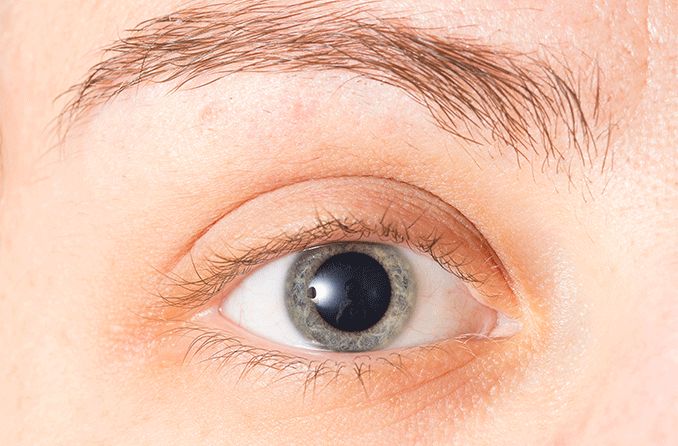Mydriasis: Definition and causes

What is mydriasis?
Mydriasis is dilation of the pupil, the black center of your eye that lets light come in. Dilation means the pupil is larger than normal. Mydriasis can occur naturally, but it can also be triggered by drops applied during an eye exam, or be caused by medication or a health condition.
Mydriasis causes
What causes mydriasis (pronounced mid-dry-uh-sis)? It can be triggered by a number of things. What follows are some of the causes.
Normal activity. It’s common for your pupils to dilate. Normal mydriasis allows more light to enter your eyes or keeps light from entering your eyes. For example, when you enter a darkened room, your pupils dilate to let in more light. It also happens in response to factors such as touch, sound and emotion.
Eye exam. During many of the more than 100 million eye exams performed in the U.S. every year, drops may be administered to dilate your pupils. This lets an eye doctor examine the optic nerves and retina at the back of your eye. This dilation typically lasts six to 24 hours.
Surgical procedure. Cataract surgery is an example of a procedure that requires pupil dilation. This form of mydriasis makes it easier for a doctor to perform the surgery.
Medication. Medication that can lead to mydriasis includes:
Antihistamines.
Decongestants.
Tricyclic antidepressants, used to treat depression, anxiety and insomnia.
Motion sickness medicine.
Anti-nausea medication.
Anti-seizure drugs.
Medication for treatment of Parkinson’s disease.
Botox and other medication with botulinum toxin.
Atropine, a drug for treatment of low heart rate and other conditions. (Certain eye drops contain atropine.)
Brain injury or disease. A stroke, brain tumor or head injury can trigger pupil dilation.
Use of recreational drugs. Several recreational drugs can affect the brain and cause mydriasis, including cocaine, methamphetamines, ecstasy (MDMA), LSD and psychedelic mushrooms. Treatment for drug abuse may resolve this kind of mydriasis.
Increased production of oxycontin. High levels of the hormone known as oxycontin (not to be confused with the drug of the same name) can temporarily lead to mild or moderate mydriasis. A greater amount of oxycontin typically is generated during childbirth, breastfeeding or even sex.
Adie syndrome. Adie syndrome is a neurological disorder that causes one pupil to be larger than normal. In most instances, the cause of Adie syndrome is not known. Treatment may not be needed, but if it is, glasses or eye drops may be necessary.
SEE RELATED: Anisocoria: What causes unequal pupil sizes?
Traumatic mydriasis
A traumatic eye injury can harm the iris and lead to a type of pupil dilation known as traumatic mydriasis. Protection from further injury to the eye may be needed and, if severe symptoms persist, surgery may be required.
Benign episodic unilateral mydriasis
A condition known as benign episodic unilateral mydriasis typically occurs in young women with either a history of migraine or a family history of migraine. The connection between benign episodic unilateral mydriasis and migraine is unclear. This condition causes temporary pupil dilation in one eye and does not require treatment.
Mydriasis and glaucoma
Mydriasis does not cause glaucoma. However, mydriasis can be a risk factor for a type of glaucoma known as angle closure glaucoma. This type of glaucoma is also called narrow angle glaucoma. Angle closure glaucoma occurs when the drainage canals of the eye are blocked.
If you have angle closure glaucoma, use of dilation drops during an eye exam may be risky. This is because the dilation may raise pressure in the eye, leading to obstructed drainage.
SEE RELATED: Miosis: What causes constricted pupils?
Mydriasis and the TikTok Benadryl challenge
A report published in 2021 in the journal Contemporary Pediatrics highlights mydriasis and more serious side effects associated with the “Benadryl challenge,” apparently promoted by users of the social media platform TikTok.
The journal says that in August 2020, Johnson & Johnson warned about the challenge. The company makes Benadryl, a brand of diphenhydramine, an antihistamine used to treat allergy symptoms, insomnia and motion sickness. The Johnson & Johnson notice followed the death of a 15-year-old girl in Oklahoma who reportedly overdosed on diphenhydramine.
This challenge, made popular on TikTok, purportedly encouraged people to take large quantities of diphenhydramine (at least 12 pills) to get high and then record videos of their reactions. This challenge led to diphenhydramine poisoning, with the first case reported in May 2020, according to Contemporary Pediatrics. The U.S. Food and Drug Administration (FDA) issued its own warning about the TikTok challenge in September 2020.
TikTok has removed any evidence of the challenge.
Effects of abusing diphenhydramine may include mydriasis, death, coma, seizures, tachycardia (rapid heart rate), delirium (sudden change in mental state, including hallucinations), sleepiness, agitation, flushed skin and difficulty urinating.
READ NEXT: Small pupils: What does it mean?
Dealing with persistent mydriasis
If you regularly experience mydriasis, your eyes will be more sensitive to sunlight. What can you do if this is the case? You may try wearing eyeglasses with photochromic lenses that automatically darken when exposed to sunlight. Sunglasses with polarized lenses also can help your eyes adjust to sunlight.
In some circumstances, you may want to explore getting fitted for prosthetic contact lenses. These lenses can make it appear that the size of your pupils is normal or can be helpful if trauma caused your mydriasis.
When should I talk to an eye doctor?
Mydriasis can be a normal response of your eye to changing levels of light, but sometimes it can be a sign of something more serious. If your pupils don’t change when the light changes, or one is noticeably larger than the other, you may need to talk to your eye doctor. In these cases, mydriasis might be a sign of an eye injury or a problem that affects the brain, like a tumor, stroke or head injury.
READ NEXT: What is a blown pupil?
Page published on Wednesday, February 3, 2021






